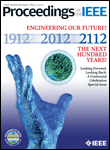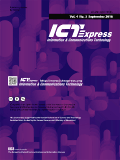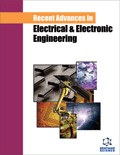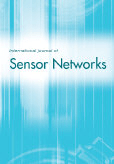
PROCEEDINGS OF THE IEEE
Scope & Guideline
Illuminating Innovations in Computer Science and Engineering
Introduction
Aims and Scopes
- Wireless Communications and Networks:
The journal emphasizes the development of next-generation wireless communication technologies, particularly focusing on multiple access techniques, massive MIMO, and integrated sensing and communications. - Artificial Intelligence in Engineering:
Research on the integration of AI techniques in engineering applications is a core focus, exploring subjects such as machine learning, deep learning, and AI-driven optimizations for various systems. - Power Electronics and Energy Systems:
The Proceedings addresses advancements in power electronics, renewable energy systems, and smart grid technologies, highlighting methodologies for enhancing efficiency and reliability. - Signal Processing and Communications:
The journal covers innovative signal processing techniques, including those applied to terahertz communications, video compression, and remote sensing, contributing to advancements in data transmission and analysis. - Robotics and Automation:
Research related to robotics, including surgical robotics, autonomous systems, and their integration with communication technologies, is a significant area of focus. - Emerging Technologies:
The journal also explores cutting-edge technologies such as quantum computing, edge intelligence, and reconfigurable intelligent surfaces, providing insights into future trends and applications.
Trending and Emerging
- Next-Generation Multiple Access Techniques:
Research on innovative multiple access techniques, particularly in the context of 6G and beyond, has surged, focusing on methods that enhance capacity and efficiency in wireless communication. - AI and Machine Learning Applications:
A significant increase in publications exploring AI and machine learning applications in engineering, including optimization in wireless networks, energy systems, and robotics, highlights the growing integration of these technologies. - Reconfigurable Intelligent Surfaces:
The exploration of reconfigurable intelligent surfaces (RIS) for enhancing wireless communication performance is emerging as a key area of interest, indicating a shift towards more adaptive and flexible network solutions. - Sustainable and Green Technologies:
There is a growing emphasis on green technologies and sustainable practices within power systems and communications, as researchers focus on energy efficiency and environmental impact. - Advanced Robotics and Automation:
Research on robotics, particularly in medical applications and autonomous systems, is trending upwards, showcasing advancements in both hardware and software integration.
Declining or Waning
- Traditional Circuit Design:
There has been a noticeable reduction in papers focusing solely on conventional circuit design techniques, as the journal shifts towards more integrated and system-level approaches that incorporate advanced technologies. - Basic Theoretical Studies:
Papers focusing exclusively on basic theoretical studies without practical applications or technological implications have become less frequent, indicating a preference for applied research that addresses real-world challenges. - Legacy Communication Technologies:
As the focus moves towards next-generation communication systems, research on older communication technologies and their applications has decreased, reflecting the industry's transition to 5G and beyond. - Static Network Architectures:
Research on static and traditional network architectures is declining in favor of dynamic, adaptive, and intelligent network solutions that leverage AI and machine learning for improved performance.
Similar Journals

IEEE Open Journal of the Communications Society
Elevating Research Standards in Computer Networks and CommunicationsWelcome to the IEEE Open Journal of the Communications Society, a premier open-access publication dedicated to advancing the fields of computer networks and communications. Launched in 2020 by the esteemed IEEE-Institute of Electrical and Electronics Engineers, this journal operates under a commitment to disseminate high-quality, peer-reviewed research that fosters innovation and collaboration within the global communications community. With an impressive impact factor and currently positioned in the Q1 category of Time's rankings for Computer Networks and Communications (2023), the journal ranks 21st out of 395 in its field, placing it within the top 6% globally. It serves as a vital forum for researchers, professionals, and students, providing them with immediate access to pioneering studies and emerging trends. Being fully open access, all published articles are freely available to enhance the reach and impact of your research. Join us in exploring transformative ideas and technologies that shape the future of communications.

Studies in Informatics and Control
Illuminating the Path of Informatics and ControlStudies in Informatics and Control is a distinguished academic journal published by the NATL INST R&D INFORMATICS-ICI, specializing in the interdisciplinary fields of Computer Science and Electrical and Electronic Engineering. With an ISSN of 1220-1766 and a recognized standing within its field, this journal aims to foster innovation and disseminate high-quality research findings from 2010 through 2024. It maintains a significant presence in the academic landscape, holding a Q3 ranking in both Computer Science (miscellaneous) and Electrical and Electronic Engineering categories for 2023, which underscores its commitment to advancing knowledge and technology in these areas. While the journal is not open access, it provides valuable insights and results that are essential for researchers, professionals, and students striving to develop their expertise in informatics and control systems. Based in Romania, its contributions traverse international boundaries, appealing to a global audience keen on the latest developments and trends within these rapidly evolving fields.

ICT Express
Fostering Global Collaboration in Computational SciencesICT Express is a leading open-access journal published by Elsevier that has established itself at the forefront of the fields of Artificial Intelligence, Computer Networks and Communications, Hardware and Architecture, Information Systems, and Software. Since its inception in 2015, this South Korea-based journal has provided a vital platform for disseminating innovative research and practical applications across these rapidly evolving domains. With an impressive impact factor and consistently high Scopus rankings—placing it in the top quartiles of its categories—it attracts contributions from both seasoned experts and emerging scholars. Current access options ensure that groundbreaking findings are readily available to a global audience, thus fostering collaboration and advancement in technology and computational sciences. As ICT continues to reshape various industries, the significance of research published in ICT Express is crucial for staying ahead in the digital landscape.

Recent Advances in Electrical & Electronic Engineering
Connecting Knowledge with Engineering SolutionsRecent Advances in Electrical & Electronic Engineering is a prominent scholarly journal dedicated to publishing cutting-edge research and developments in the fields of electrical and electronic engineering. Published by BENTHAM SCIENCE PUBL LTD, this journal aims to disseminate significant findings that advance knowledge and technology across various disciplines related to electrical and electronic engineering. With an ISSN of 2352-0965 and an E-ISSN of 2352-0973, the journal is accessible to a global audience, facilitating open scholarly discourse. Although it currently holds a Q4 ranking in both electrical and electronic engineering and materials science categories, it contributes to ongoing dialogues critical for advancing innovations within these sectors. Notably, the journal’s convergence years span from 2007 to 2024, securing its continual relevance in an evolving academic landscape. With a commitment to high-quality research, this journal serves as an essential resource for researchers, professionals, and students seeking to stay abreast of advancements and emerging challenges within the realm of electrical and electronic engineering.

Radio Electronics Computer Science Control
Advancing Knowledge in Radio Electronics and Control SystemsRadio Electronics Computer Science Control is a distinguished academic journal published by the ZAPORIZHZHYA NATIONAL TECHNICAL UNIVERSITY that has been committed to advancing the fields of radio electronics, computer science, and control systems since its inception in 1999. With an open access model, the journal ensures that high-quality research is freely available to a global audience, fostering collaboration and innovation among researchers, professionals, and students alike. While the current impact factor is not listed, the journal remains an essential resource for those seeking to explore cutting-edge developments in technology and engineering, contributing significantly to the interdisciplinary dialogue among scholars in these domains. The journal publishes original research articles, reviews, and case studies, making it a vital platform for disseminating knowledge and advancing scientific understanding in the rapidly evolving landscape of computer and control systems. Located in Zaporizhzhya, Ukraine, the journal serves as a beacon of scholarly communication in Eastern Europe and beyond.

International Journal of Autonomous and Adaptive Communications Systems
Advancing the Future of Autonomous Communication TechnologiesInternational Journal of Autonomous and Adaptive Communications Systems, published by INDERSCIENCE ENTERPRISES LTD, serves as a vital platform for researchers and professionals engaged in the dynamic fields of autonomous systems and adaptive communication technologies. Since its inception in 2008, this peer-reviewed journal has contributed to the advancement of knowledge within the realms of Computer Science and Electrical and Electronic Engineering, albeit currently positioned in the Q4 quartile, suggesting substantial opportunities for growth and influence within these disciplines. With an emphasis on innovative research tackling challenges in autonomous communication frameworks, the journal invites submissions that explore the convergence of various technologies and their applications. While the journal does not offer open access, it remains a significant resource for academia and industry at large, facilitating collaboration and dialogue among emerging scholars, seasoned experts, and applied practitioners in the UK and beyond. The journey of this journal from 2008 to its ongoing publications through 2024 reflects a commitment to fostering academic discourse in this essential area of study.

IEEE COMMUNICATIONS MAGAZINE
Navigating the Evolving Landscape of TechnologyIEEE Communications Magazine, published by the Institute of Electrical and Electronics Engineers (IEEE), is a leading journal in the fields of Computer Networks and Communications, Computer Science Applications, and Electrical and Electronic Engineering. With an impressive impact factor reflected in its Q1 quartile rankings across multiple categories, this periodical stands at the forefront of technological advancement and innovation. Since its inception in 1979, the magazine has been committed to disseminating high-quality research and insightful reviews that address current issues in communications technology. Targeting an audience that includes researchers, industry professionals, and students, IEEE Communications Magazine strives to foster a deeper understanding of emerging trends and challenges in the communications sector. Its affiliation with IEEE, a global leader in advancing technology, underlines the journal's credibility and significance in supporting scholarly communication in electrical and electronic engineering. The magazine operates without open access options, necessitating subscription or institutional access for its comprehensive content.

International Journal of Sensor Networks
Connecting Ideas in Engineering and TechnologyInternational Journal of Sensor Networks, published by INDERSCIENCE ENTERPRISES LTD, is a pivotal resource in the realms of Computer Networks and Communications, Computer Science Applications, Control and Systems Engineering, and Electrical and Electronic Engineering. With an ISSN of 1748-1279, this journal serves as a vital platform for disseminating innovative research and developments related to sensor networks, highlighting groundbreaking work that spans from fundamental sensor technology to sophisticated applications in various engineering fields. The journal, which operates without an open access model, features a convergence of contributions from 2006 to 2024, holding a Q3 ranking across multiple categories as per the 2023 categorization, which reflects its standing and influence within the academic community. Targeted at researchers, professionals, and students, the International Journal of Sensor Networks not only fosters interdisciplinary dialogue but also drives the advancement of technology by publishing quality papers that address contemporary challenges in sensor networks and their applications.

Journal of Electromagnetic Engineering and Science
Illuminating the Future of Electromagnetic EngineeringThe Journal of Electromagnetic Engineering and Science (ISSN: 2671-7255, E-ISSN: 2671-7263) is a premier Open Access journal published by the Korean Institute of Electromagnetic Engineering & Science. Since its establishment in 2001, it has been dedicated to advancing knowledge in the fields of Electrical Engineering, Electromagnetic Theory, and Communications, making significant contributions to both academia and industry. The journal holds an impressive Q2 quartile ranking in notable categories such as Computer Networks and Communications and Electrical and Electronic Engineering as of 2023, reflecting its robust scientific impact and reputation. It is indexed in Scopus, with commendable rankings in multiple fields, enhancing its visibility and reach among researchers. The journal's open-access model ensures that cutting-edge research is accessible to a global audience, fostering collaboration and innovation. Researchers, professionals, and students in the domain are encouraged to contribute and engage with high-quality articles that cover the latest advancements and trends in electromagnetic engineering and associated sciences.

IEEE Open Journal of Industry Applications
Fostering excellence in electrical and manufacturing research.IEEE Open Journal of Industry Applications is a premier open-access publication established in 2020 by the esteemed IEEE-INST ELECTRICAL ELECTRONICS ENGINEERS INC, dedicated to advancing the fields of Control and Systems Engineering, Electrical and Electronic Engineering, and Industrial and Manufacturing Engineering. With a strong commitment to disseminating high-quality research, the journal has rapidly garnered recognition, achieving a Q1 quartile ranking in multiple engineering categories, notably securing a rank of 21st out of 321 in Control and Systems Engineering and 26th out of 384 in Industrial and Manufacturing Engineering as of 2023. This journal not only facilitates immediate access to cutting-edge findings but also fosters an inclusive academic environment where researchers, professionals, and students can engage with and contribute to the evolving landscape of industry applications. By embracing open access, it ensures that pivotal research is freely available, thereby maximizing its impact on the scientific community. For potential contributors and readers, the journal's robust Scopus rankings—placing it in the top 7% of its fields—highlight its significance as a leading platform for innovative discussions and explorations in engineering.